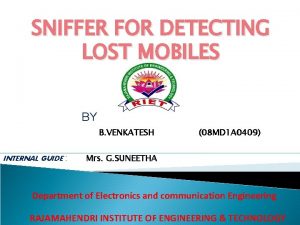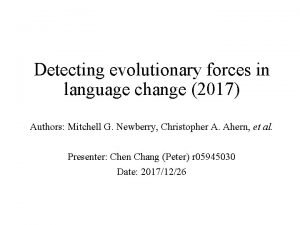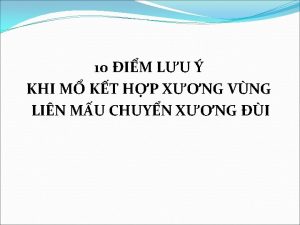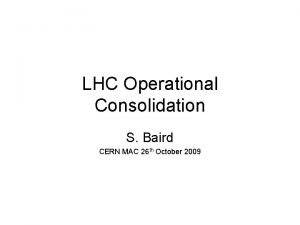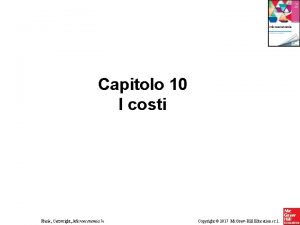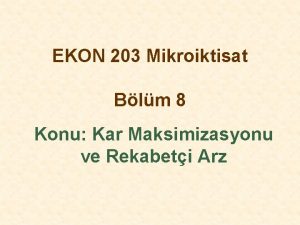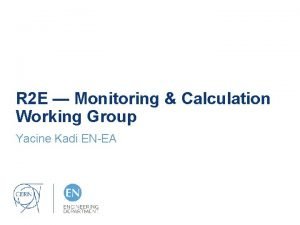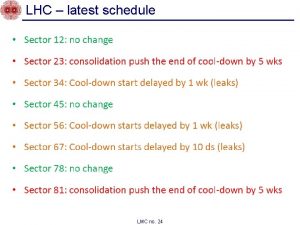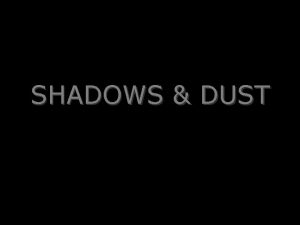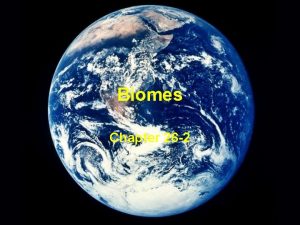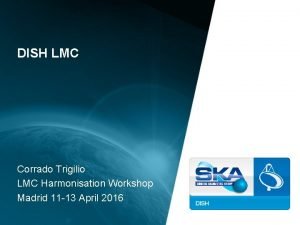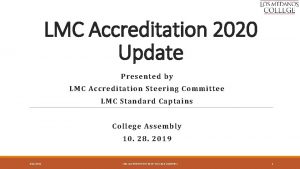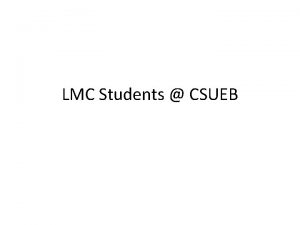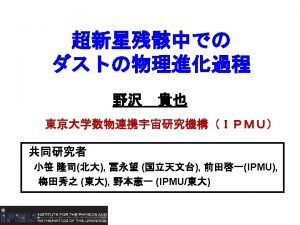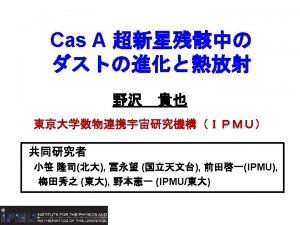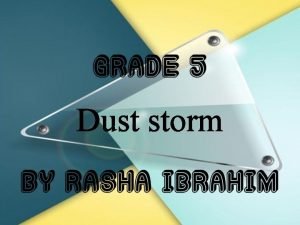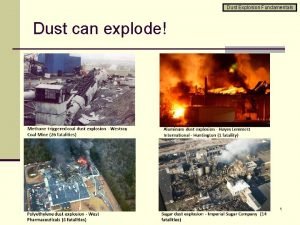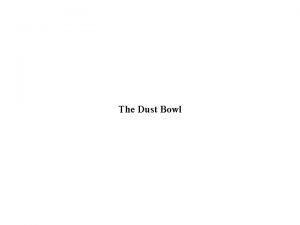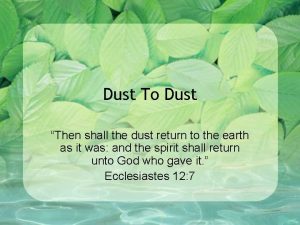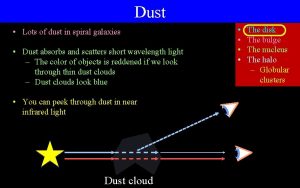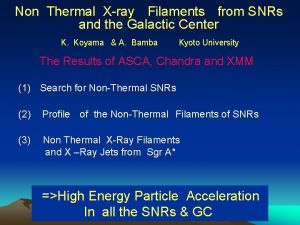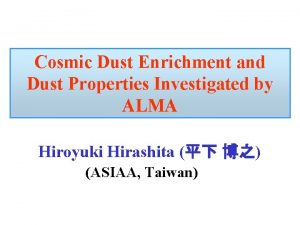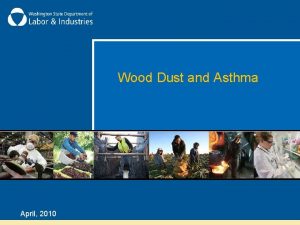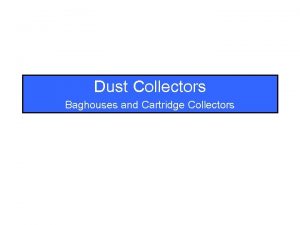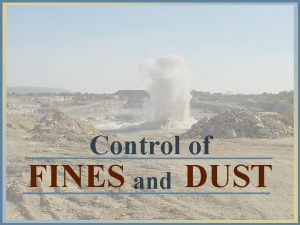Detecting Cool Dust in SNRs in LMC and




















- Slides: 20

Detecting Cool Dust in SNRs in LMC and SMC with ALMA Takaya Nozawa (Kavli IPMU) and Masaomi Tanaka (NAOJ) Targets ・ SN 1987 A: our proposal for ALMA Cycle 0 and next plan for ALMA Cycle 1 ・ 1 E 0102. 2 -7219: youngest SNR in SMC 2012/6/11

1. SNRs at submm and millimeter wavelengths ・ molecular lines and synchrotron emission from interaction regions between molecular clouds and SN blast waves ・ synchrotron emission from pulsar wind nebulae ・ thermal emission from cool dust which was formed in the expanding ejecta of SNe ➔ cool dust dominates the dust mass ➔ discovery of a huge amount of dust at z > 5 SNe are important sources of interstellar dust?

2. Summary of dust mass in core-collapse SNe cool dust in SN 1987 A theory missing cold dust? young SNRs swept-up IS dust? young SNe Far-IR to sub-mm observations are essential for revealing the mass of dust grains produced in the ejecta of SNe

3. Herschel detects cool dust in SN 1987 A Matsuura et al. 2011 Herschel detects cool (~20 K) dust of ~0. 4 -0. 7 Msun toward SN 1987 A!

4. Resolving cool dust in SN 1987 A with ALMA Band 7 (850 μm) ALMA Cycle 0 Proposal ‘Detecting cool dust in SN 1987 A’ Band 9 (450 μm) (TN, Tanaka, et al. ) 2 arcsec CASA simulation with extended config. (4 hrs) 0. 1 Msun of silicate ➔ 5σ detection at Band 9 !!

5. Constraining mass of cool dust in SN 1987 A Herschel results had not yet opened at that time … Lakicevic+12, A&A, 541, L 1 3 mm If detected with 2. 7 m. Jy, more than 0. 06 Msun of grains exist !! Lakicevic+12, A&A, 541, L 2

6. Successful ALMA proposals for SN 1987 A This proposal was ranked in the highest priority, to be observed this fall !! Band 9 extended configuration Band 3, 6, 7, 9 compact configuration

Band 3 Band 6 Band 7 Band 9 100% 70% 40% 10% da y tim e id ni gh t Fraction m da y tim e 7. Condition of atmosphere LMC From ALMA Cycle 1 proposer’s guide

8. 12 m-array configurations for ALMA Cycle 1 compact Cycle 0 proposal (extended, Band 9) Ang Res : 0. 23” Max Res : 1. 5” extended Cycle 1 proposal ・ Band 6, 7, and 9 ・ C 32 -5 or C 32 -6 or mixed confguration?

9. Possible target: SNR 1 E 0102, a twin of Cas A 24 μm X-ray, radio ・ SNR 1 E 0102 - O-rich (Type Ib? ) - age : ~1000 yr - Mwarm ~ 10 -3 Msun - Mcool ~ ? ? ? Stanimirovic+05 24 μm Gaetz+00 100 μm ・ Cassiopeia A - Type IIb - age : 330 yr - Mwarm < 10 -2 Msun - Mcool ~ 0. 07 Msun Cas A model (Nozawa+10) Barlow+10, A&A, 518, L 138

10. IR observations of SNR 1 E 0102 24 μm 70 μm Spitzer; Stanimirovic+05 ・ SNR 1 E 0102 in SMC - age : ~1000 yr youngest CCSNe - diameter : ~40” (= 12 pc @ 60 kpc) - similar to Cas A ・ hot dust mass - Mwarm = 8 x 10 -4 Msun (Stanimirovic+05) - Mwarm = 0. 014 Msun Mwarm = 3 x 10 -3 Msun (Rho+09) ・ cool dust mass - Mcool < 0. 6 Msun with Tdust = 20 -30 K Sandstrom+09, Ap. J, 696, 2138 (Sandstrom+09)

11. Comparison with SED of SN 1987 A IR SED of SNR 1 E 0102 Cycle 1 1 sigma, 1 hr IR-to-radio SEDs of SN 1987 A and 1 E 0102 are similar But. .

12. SNR 1 E 0102 is too extended! SN 1987 A 40 arcsec

13. Array & ACA combinations ・ Use of ACA requires 3 times more times ・ Atmospheric correction is not available on ACA ・ Total Power (TP) is not available for continuum

14. What is the best strategy for SNR 1 E 0102? Band 3 with ACA Band 3 Band 9 with ACA SN 1987 A 40 arcsec

15. Flux estimates necessary for detection 1987 A Band 9 1 E 0102 Band 9 full operation 1 sigma, 1 hr effective flux (flux per beam)

16. Summary Detecting cool dust in SNRs with ALMA ・ SN 1987 A (radius: 0. 5 arcsec) - Spatially resolved images in Band 6, 7, and 9 - Possibility of detecting molecular lines? ・ 1 E 0102. 2 -7219 (radius: 20 arcsec) - too large and too faint (almost impossible) ➔ it seems too hard to detect continuum emission from cool dust in any other SNRs. .

A-1. How dense is cool dust in 1 E 0102? ・ 1 E 0102. 2 -7219 R = 15 arcsec ➔ 1. 3 x 1019 cm = 4. 4 pc @ 60 kpc what is the mass of dust if ISM dust is included in the sphere with this radius? Mdust ~ (4πR 3 / 3) D (n. H m. H) = 0. 077 Msun (D / 0. 01) (n. H / 1 cm-3) ・ Cassiopeia A R = 100 arcsec ➔ 4. 8 x 1018 cm = 1. 6 pc @ 3. 4 kpc

A-2. Importance of molecular lines in SN 1987 A ・ CO and Si. O molecules were detected around 300 days after explosion in SN 1987 A (CO and Si. O were confirmed in many dust-forming SNe) ・ Measuring the expansion velocity of the ejecta ・ CO molecule has been detected in Cas A SNR ・ All condensible metals have to be tied up in dust grains to explain 0. 4 -0. 7 Msun of dust in SN 1987 A ➔ CO and Si. O molecules can survive? ? ・ How much CO and Si. O line fluxes can contribute the continuum flux? ➔ expected mass of CO and Si. O: ~10 -3 Msun

A-3. Summary of molecular lines Band 3: 84 -115 GHz Band 6: 211 -274 GHz Band 7: 275 -373 GHz Band 9: 607 -720 GHz ・ CO molecule ・ Si. O molecule ν=0, 1 -0: 115. 271 GHz (B 3) ν=0, 2 -1: 230. 538 GHz (B 6) ν=0, 3 -2: 345. 796 GHz (B 7) ν=0, 4 -3: 461. 041 GHz ν=0, 5 -4: 576. 268 GHz ν=0, 6 -5: 691. 473 GHz (B 9) ν=0, 2 -1: 86. 847 GHz (B 3) ν=0, 3 -2: 130. 269 GHz ν=0, 4 -3: 173. 688 GHz ν=0, 5 -4: 217. 105 GHz (B 6) ν=0, 6 -5: 260. 518 GHz (B 6) ν=0, 7 -6: 303. 927 GHz (B 7) ν=0, 8 -7: 347. 331 GHz (B 7) ν=0, 15 -14: 650. 958 GHz (B 9) ν=0, 16 -15: 694. 296 GHz (B 9)
 Sniffer for detecting lost mobiles
Sniffer for detecting lost mobiles Detecting evolutionary forces in language change
Detecting evolutionary forces in language change Silver ticket attack
Silver ticket attack How do fraud symptoms help in detecting fraud
How do fraud symptoms help in detecting fraud Havex
Havex Lmc branching
Lmc branching Absolute addressing mode
Absolute addressing mode Lmc nova
Lmc nova Gãy lmc
Gãy lmc Baird lmc
Baird lmc Lac lmc
Lac lmc Ekon kar
Ekon kar Lmc mcwg
Lmc mcwg Ti8 schedule
Ti8 schedule Lmc brp
Lmc brp I abhor myself and repent in dust and ashes
I abhor myself and repent in dust and ashes Tsade rp
Tsade rp Used to lay out any noncircular curve
Used to lay out any noncircular curve Fierceness and ambition
Fierceness and ambition Hot cold media
Hot cold media A biome that is cold, dry and treeless.
A biome that is cold, dry and treeless.
